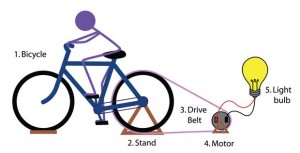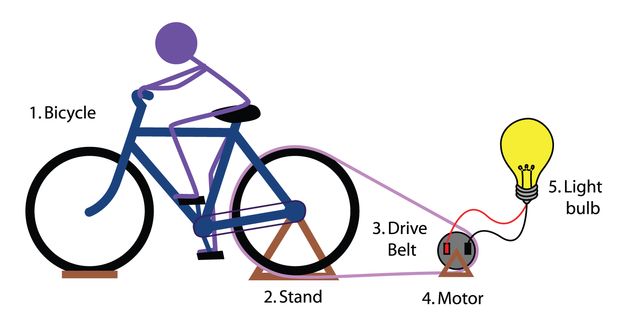Anyone who has had the *pleasure* of hand cranking anything can agree that there isn’t much pleasure in it. In an emergency that causes an off grid environment, having tools with a hand crank are very convenient to have around. That said, their downfall lies in the time aspect. Isn’t there a better way to put that energy to good use? You bet there is!
Sweat Equity Put To Very Good Use
One creative solution is learning how to convert existing items you have in and around your home into providing shortcuts to make the most of your time. Many of us have an old bicycle or stationary bike collecting dust in the corner of the home. Why not put it to practical use and use it to produce food or energy?
The muscle groups in the legs are much larger compared to the muscles in the arms and can provide a better energy conversion. This is also a great way to introduce more physical fitness into many of our sedentary lifestyles. Being prepared physically is often overlooked in our preparedness endeavors. Moreover, if you find yourself in a disaster and find yourself more anxious and nervous, then this is also a healthy way to alleviate the stresses that go along with being in the midst of a crises. Here are three ways to put that sweat equity to use around the home.
Battery Charger
When a stationary bike is converted to make energy, essential your pedaling will be used to crank or produce the energy required to manufacture the battery. Keep in mind that these can be used to charge batteries or power small household appliances such as, a desktop PC, laptop, or stereo. You will not be able to charge large appliances, such as a refrigerator. The power needed to run a fridge is well beyond the amount of power you can produce with your legs. But you could charge DC batteries or even a battery bank.
There are multiple to go about making this project:
- Purchase Online – Purchase an online conversion kit, such as the 400 Watt Pedal-A-Watt [2]. According to the website, it allows you to drop your own bicycle into the stand, secure it in under 10 seconds, pedal and create up to 400 watts.
- Do It Yourself – If you choose to make this a DIY project, here are the parts you will need [3].
- Using a car alternator – If you do not have a stationary or exercise bike, you can use a bicycle as well. Another option is to hook a car alternator up to the bicycle to generate electricity. Here is an excellent video [4] explaining how to convert the bicycle into an energy producer.
- Using an old washing machine – A bike generator can also be made from an old washing machine. Here are some basic instructions [5].
Wheat Grinder
A stationary bike can also be used to grind wheat. By attaching the bike to a pulley, and creating a small amount of tension, the pedals will turn the pulley and grind the wheat. Here are some basic instructions [6] for hooking your grain mill up to an stationary bicycle.
Wash Clothing
While we’re at it, why not do some laundry with a stationary bike. Doing laundry [7] “old school” requires a wringer and a lot of elbow grease. Perhaps there is an easier approach. Use a stationary bicycle and an assembly of belts and pulleys to connect it to an old, salvaged washing machine tub. Read more here [8].
The Downside to This Energy Method
I should clarify that many believe this form of energy production is inefficient in terms of internal energy losses in the battery, the battery management system, other electronic parts, and the motor/generator. In an article [9] on the subject, the author writes, “If you produce 100 watts of power and 42 to 67.5 percent is lost in the conversion, there is only 32.5 to 58 watts left to power the device. If you power the same device mechanically, you deliver 100 watts straight to it. You thus have to pedal 2 to 3 times as hard or as long if you choose to take the intermediate step of generating electricity and storing it in a battery.”
Your Saving Grace
That said, if you find yourself in a long term disaster where living off grid is the new normal, this energy production source, although archaic, may be your saving grace. This is a creative solution to keeping your way of life going and can help you adapt to a new way of life more seamlessly.

